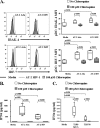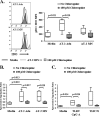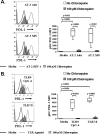Chloroquine modulates HIV-1-induced plasmacytoid dendritic cell alpha interferon: implication for T-cell activation
- PMID: 19949061
- PMCID: PMC2812138
- DOI: 10.1128/AAC.01246-09
Chloroquine modulates HIV-1-induced plasmacytoid dendritic cell alpha interferon: implication for T-cell activation
Abstract
Plasmacytoid dendritic cells (pDC) contribute to antiviral immunity mainly through recognition of microbial products and viruses via intracellular Toll-like receptor 7 (TLR7) or TLR9, resulting in the production of type I interferons (IFNs). Although interferons reduce the viral burden in the acute phase of infection, their role in the chronic phase is unclear. The presence of elevated plasma IFN-alpha levels in advanced HIV disease and its association with microbial translocation in chronic HIV infection lead us to hypothesize that IFN-alpha could contribute to immune activation. Blocking of IFN-alpha production using chloroquine, an endosomal inhibitor, was tested in a novel in vitro model system with the aim of characterizing the effects of chloroquine on HIV-1-mediated TLR signaling, IFN-alpha production, and T-cell activation. Our results indicate that chloroquine blocks TLR-mediated activation of pDC and MyD88 signaling, as shown by decreases in the levels of the downstream signaling molecules IRAK-4 and IRF-7 and by inhibition of IFN-alpha synthesis. Chloroquine decreased CD8 T-cell activation induced by aldrithiol-2-treated HIV-1 in peripheral blood mononuclear cell cultures. In addition to blocking pDC activation, chloroquine also blocked negative modulators of the T-cell response, such as indoleamine 2,3-dioxygenase (IDO) and programmed death ligand 1 (PDL-1). Our results indicate that TLR stimulation and production of IFN-alpha by pDC contribute to immune activation and that blocking of these pathways using chloroquine may interfere with events contributing to HIV pathogenesis. Our results suggests that a safe, well-tolerated drug such as chloroquine can be proposed as an adjuvant therapeutic candidate along with highly active antiretroviral therapy to control immune activation in HIV-1 infection.
Figures





References
-
- Abe, M., Z. Wang, A. de Creus, and A. W. Thomson. 2005. Plasmacytoid dendritic cell precursors induce allogeneic T-cell hyporesponsiveness and prolong heart graft survival. Am. J. Transplant. 5:1808-1819. - PubMed
-
- Akira, S., K. Takeda, and T. Kaisho. 2001. Toll-like receptors: critical proteins linking innate and acquired immunity. Nat. Immunol. 2:675-680. - PubMed
-
- Almeida, M., M. Cordero, J. Almeida, and A. Orfao. 2005. Different subsets of peripheral blood dendritic cells show distinct phenotypic and functional abnormalities in HIV-1 infection. AIDS 19:261-271. - PubMed
-
- Andersson, J., A. Boasso, J. Nilsson, R. Zhang, N. J. Shire, S. Lindback, G. M. Shearer, and C. A. Chougnet. 2005. The prevalence of regulatory T cells in lymphoid tissue is correlated with viral load in HIV-infected patients. J. Immunol. 174:3143-3147. - PubMed
MeSH terms
Substances
LinkOut - more resources
Full Text Sources
Other Literature Sources
Medical
Research Materials

